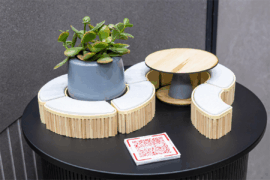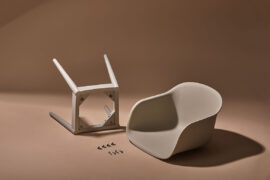A timber canopy wraps around the ceiling and walls of Hunan Slurp, evocative of the slippery strands of noodles served in the New York City venue.
Hunan Province in Southern China is famed for its cuisine, which is deeply rooted in Hunan people’s customs and identity. Drawing on this heritage, Hunan Slurp in New York is named for the everyday meal of Hunan people and the satisfying sound made when eating the traditional warm rice noodle soup.
Hunan Slurp is the restaurant of chef and artist Chao Wang who was born in Hengyang in Hunan Province. Wanting to cure his homesickness through cooking, he conceived of the restaurant and engaged New Practice Studio to design the venue. “The idea was to create a bright and natural feel in the space for the younger patrons in the East Village,” says Nianlai Zhong, founding partner and principal at New Practice Studio. The firm designed a rhythmic timber canopy that wraps around the ceiling and walls and is evocative of the slippery strands of noodles.
“The space is conceived as a place to look into and look out from,” says Nianlai. “A continuous volume is carved out from the storefront into the interior so a direct dialogue is established between the street and the restaurant.”
The timber canopy accentuates the long and narrow space to create a tunnel that arcs over the communal dining tables. Fabricated with laminated wood panels and covered with oak veneers, the canopy has rounded corners that reinforce the geometry of the venue. The existing brick wall is visible behind the ribbed timber, and backlighting highlights its texture and adds another dimension to the space.
“The idea for the curved wood screen is on the one hand to create a spatial element that can resemble the food served in the space, and on the other hand to engage with the existing brick walls to create a subtle layering in the space,” says Nianlai.
Hand-blown bulbs are suspended over the brass stools and oak-veneer dining tables, which are set with ceramic plates and wooden chopsticks. Cosier dining is in the rear of the restaurant with marble-top tables and a long banquette. Sleek round mirrors reflect the golden glow of the lights, and diners can see into the kitchen through the glass walls.
Sitting within the ribbed belly of the restaurant, diners are immersed within the noodle-inspired canopy and the satisfying slurp that expresses appreciation to the chef.
–
Want more hospitality design inspiration? Take a look in the archives. And for regular updates, join our mailing list.
INDESIGN is on instagram
Follow @indesignlive
A searchable and comprehensive guide for specifying leading products and their suppliers
Keep up to date with the latest and greatest from our industry BFF's!

From the spark of an idea on the page to the launch of new pieces in a showroom is a journey every aspiring industrial and furnishing designer imagines making.

Merging two hotel identities in one landmark development, Hotel Indigo and Holiday Inn Little Collins capture the spirit of Melbourne through Buchan’s narrative-driven design – elevated by GROHE’s signature craftsmanship.

With the opening of the 2026 INDE.Awards program, now is the time to assess your projects, ensure photography is at hand and begin your submissions.

Winners of the 2025 Habitus House of the Year and Editor’s Choice Award respectively, Anthony Gill and Jason Gibney join the podcast to discuss the state of housing in Australia today.
The internet never sleeps! Here's the stuff you might have missed

Director Farrokh Derakhshani joins STORIESINDESIGN podcast from Geneva to talk about the wide-ranging Aga Khan Award, which in 2025 awarded $1m to a series of winners with projects from China to Palestine.

MillerKnoll releases the 2025 Better World Report showcasing how design can drive meaningful change through measurable progress across social, environmental and governance initiatives

The FlexiFlange leak control flange is set to revolutionise the task of installing drainage systems alongside vertical surfaces like walls and floor junctions.

Hiwa, the University of Auckland’s six-storey recreation centre by Warren and Mahoney with MJMA Toronto and Haumi, has taken out Sport Architecture at the 2025 World Architecture Festival. A vertical village for wellbeing and connection, the project continues its run of global accolades as a new benchmark for campus life and student experience.